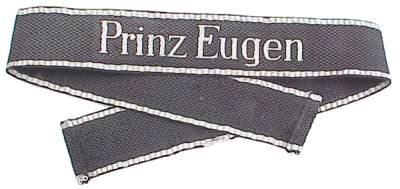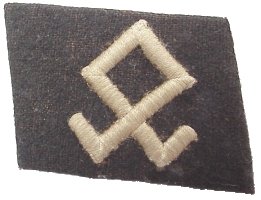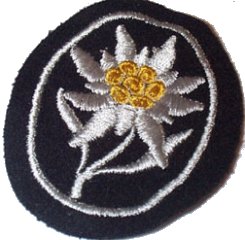
The Division was formed on March 1942 from Volksdeutsche (ethnic Germans) from Croatia, Serbia (Banat), Hungary and Romania (Siebenbürg). In its innitial phases all soldiers were volunteers but this later changed when conscription was introduced. The unit itself was formed from a SS Selbstschutz (SS Protection Force) and the Einsatz-Staffel (ES) (Also called Prinz Eugen) from Croatia and named SS-Freiwilligen-Division Prinz Eugen.
The Gebirgs Division was forming up until autumn 1942 when it gathered some 21.500 soldiers. Its weaponry was mainly composed of captured equipment such as Czech machine guns and French light tanks. When the forming was complete it was designated to the Balkans as an anti-partisan mountain division – the fist such division in Yugoslavia since 1941.
The first actions Prinz Eugen participated in were near the Serbian-Montenegro border in the mountains east of the Ibar River. Soon afterwards, it was transferred to the Zagreb-Karlovac area, where it took part in operation Weiß which in conjunction with the Italian forces aimed at the annihilation of Tito’s partisans. Weiß I lasted from 20 January – 15 February 1943, Weiß II from 25 February to mid-March 1943, while Weiß III- was cancelled. The operation didn’t achieve its goals and most of the partisans managed to evade the main attack. In May the division participated in another offensive, this time against the Serbian guerilla forces under General Draza Mihailović in Hercegovina and Montenegro. Operation Schwarz began on 15 May and ended on 15 June 1943. Prinz Eugen advanced alongside the 1. Gebirgs-Division, elements of the “Brandenburg” Regiment, 369. (Kroatische) Infanterie-Division, 118. Jäger-Division and 104. Jäger-Division. The Division attacked Mostar in Hercegovina and also deployed battalion strength elements northwest of Sarajevo. The operation was succesfull and Mihailović had to retreat to Serbia with the remains of his forces. The Division was later accoused of many warcrimes towards civilians during the latter operation. In August 1943, Prinz Eugen became a part of the XV Gebirgs-Armeekorps and was sent to the Dalmatian coast. After it disarmed the Italian forces in September, it helped to occupy the Hvar, Brac and Korcula islands and the Pelješac peninsula. From there the unit was taking part in another anti-partisan action in Makarska littoral from Omis to Ploce and Biokovo named Landsturm.
In August-September 1943 the division transferred 16 B2 tanks to Panzer-Kompanie z.b.V. 12 in exchange for 9 Hotchkiss 38 tanks. The Division was reorganised on 22 October 1943 and was renamed to 7. SS-Freiwilligen-Gebirgs-Division Prinz Eugen. In November the unit subordinated itself to the V SS Freiwilligen-Gebirgskorps and took part in anti-partisan sweeps Kugelblitz (6 Dec 1943) and Schneesturm. In January 1944, the 7th SS was transferred to the Split and Dubrovnik areas for training and to finish the reorganisation. They were once again ready for action in March (when they launched a “purge action” from Sinj resulting in massacres of civilians) and again took part in anti-partisan sweeps such as Maibaum on 23 April 1944. The next big offensive, in which Prinz Eugen participated, was the assault on Drvar, codenamed Rösselsprung, which began on 25 May 1944. The goals of this operation were to kill or capture Tito on the Drvar island with the SS-Fallschirmjäger-Bataillon 500, the 1. Brandenburg Regiment of the Division Brandenburg and other units with a massive support of the Luftwaffe. After Drvar the SS-Gebirgs-Division was sent to more anti-partisan operations. In May the Division also saw action in operations Waldrausch, Freie Jagd in June and July and Rübezahl (12 Aug – 30 Aug 1944), which prevented the partisans from moving into Montenegro. During that time the Red Army advanced to the Balkans and the division began fighting Russian and Bulgarian units suffering heavy casualties in the process.
On 21 September 1944, SS-Obergruppenführer Artur Phleps, the division’s first commander was believed to have been killed when en route from Montenegro to Transylvania, where he was to form a frontline against the Red Army. Regiment 13 of the Division received the honour title “Artur Phleps” on 13 November 1944. It was at that time that the division saw action in one of the most crucial operations in the Balkans so far. Linking up with 13. Waffen-Gebirgs-Division der SS Handschar (kroatische Nr. 1), the remnants of the 23. Waffen-Gebirgs-Division der SS Kama (kroatische Nr. 2) and 21. SS Waffen-Gebirgs-Division der SS Skanderbeg (albanische Nr. 1), Prinz Eugen created the Vardar corridor in Macedonia allowing the retreat north of- 350,000 German soldiers from occupation duties in the Aegean and Greek regions. While fighting in the bridgehead they became subordinated to the Armeekorps Müller under Generaloberst Alexander Löhr’s Heeresgruppe E. On 20 October 1944, the Red Army captured Belgrade and Prinz Eugen retreated through Čačak, Užice, Bajina Basta, Ljubovija, Zvornik, Bijeljina, to Brčko and over Drina, acting as a rear-guard to the German retreat. Due to heavy casualties the divisional SS-Kavallerie-Abteilung 7 was disbanded.
In the beginning of November the “SS Skanderberg” Division was disbanded and its remnants incorporated into the 14. Regiment of Prinz Eugen, which received its honour title “Skanderbeg”. The fighting around Nišch in October caused the unit some heavy casualties and the the 7th SS was sent for refreshing. In January 1945 the Division once again fought the Red Army and Tito’s partisans around Otok and Vukovar. The retreat from Bosnia continued and Prinz Eugen soon retreated to Croatia in April, where it was to hold its positions south of Karlovac on 2 May 1945. On 10 May 1945 the Division retreated towards Celje in Slovenia where it surrendered on 11 May 1945 to Yugoslav forces.
This unit took part in anti-partisan operations in Croatia.
Known war crimes
It took part in the killing of Jews in the town of Split, Croatia.
On 7 June 1943 and estimated 500 civilians were killed by soldiers from the Prinz Eugen division near the village of Dola. (6)
A battalion from the division took part in the relation operation against villages Otok, Cornji, Ruda, and Dolac Delnji in Dalmatia 27-28 March 1944 killing an estimated 834 civilians following a partisan attack on a supply column. (3)
On 28 March 1944 elemets from Prinz Eugen and 369. Infanterie-Division killed 80 civilians in the town of Blazevici. (5)
The division has been accused of a large number of war crimes in their anti-partisan operations, as an example SS-Sturmbannführer Breimeier issued the following proclamation:
On 3 November 1943, around 2000 hours, a German soldier on the Velika Street in Sinj was ambushed and killed. Since, despite all efforts, the culprit has not been found and the population has not supported us in this matter, 24 civilians will be shot and one hanged. The sentence will be carried out on 5 November 1943 at 0530 hours. (1)
Sonderkommando Bothmann (also known as Sonderkommando Lange) from the Chelmno extermination camp, the staff responsible for the killings there, was transferred to the division in late April 1943. (4)
Lineage
Freiwilligen-Gebirgs-Division (Mar 1942 – Apr 1942)
SS-Freiwilligen-Division Prinz Eugen (Apr 1942 – Oct 1942)
SS-Freiwilligen-Gebirgs-Division Prinz Eugen (Oct 1942 – Oct 1943)
7. SS-Freiwilligen-Gebirgs-Division Prinz Eugen (Oct 1943 – May 1945)
Commanders
SS-Obergruppenführer Artur Phleps (30 Jan 1942 – 15 May 1943)
SS-Brigadeführer Carl Reichsritter von Oberkamp (15 May 1943 – 30 Jan 1944)
SS-Brigadeführer Otto Kumm (30 Jan 1944 – 20 Jan 1945)
SS-Brigadeführer August Schmidhuber (20 Jan 1945 – 8 May 1945)
Deputy Commander and Infantry Leader
SS-Standartenführer d.R. Stefan Hedrich (1 Mar 1942 – 5 June 1943) (2)
Chief of Staff
SS-Hauptsturmführer Erich Eberhardt (1 Mar 1942 – ? June 1943)
SS-Sturmbannführer Herbert Wachsmann (? June 1943 – 1 Aug 1944)
SS-Sturmbannführer Friedrich Christoph (? 1945 – 1 Mar 1945)
SS-Sturmbannführer Josef Sepp Niedermayer (? 1945 – ? May 1945)
Quartermaster
SS-Hauptsturmführer Schmidt (1 Mar 1942 – 2 July 1943)
SS-Sturmbannführer Robert Zeller (? 1943 – 22 Oct 1943)
SS-Hauptsturmführer Fritz Greindl (? – 1 Aug 1944)
SS-Hauptsturmführer Hannes Richter (? – 1 Mar 1945)
Area of operations
Balkans (Jan 1942 – Apr 1945)
Austria (Apr 1945 – May 1945)
Subordination
12. Armee (Nov 1942 – Jan 1943)
Heeresgruppe E (Feb 1943 – Aug 1943)
XV Korps (Sep 1943 – Nov 1943)
V. SS-Freiwilligen-Gebirgs-Korps (Dec 1943 – Sep 1944)
Armeekorps Müller (Oct 1944 – Nov 1944)
XXXIV Korps (Dec 1944 – Jan 1945)
LXXXXI Korps (Feb 1945)
XXI Korps (Mar 1945)
LXIX Korps (Apr 1945)
Manpower strength
Dec 1942 19.835
Dec 1943 21.120
June 1944 18.835
Dec 1944 20.000
Honor titles
This division was named after Prinz Eugen von Savoyen (Prince Eugene of Savoy, 18 Oct. 1663 – 21 April 1736), an Austrian statesman and field marshal who, among other victories, defeated the Turks at Zenta in 1697, won several battles in the Spanish War of Succession and conquered Fortress Belgrade in 1717 during the Turkish War of 1716 – 17. His name was chosen as the division’s honor title because many of his victories took place in the area of the later Yugoslavia, i.e. the division’s theater of operations.
One of the division’s regiments was also named:
SS-Frw.-Gebirgsjäger-Rgt. 13 „Artur Phleps“
Artur Phleps (29 Nov. 1881 – 21 Sept. 44), a former Rumanian Army General, was an SS-Obergruppenführer who had formed the “Prinz Eugen” division and was its first commander until succeeded by Carl Reichsritter von Oberkamp in July 43, when he took over command of V. SS-Gebirgs-Korps. Phleps was captured and subsequently killed by Russian troops along with his driver and adjutant.
Holders of high awards
Holders of the German Cross in Gold (8)
– Breimaier, Wilhelm, 10.03.1945, SS-Sturmbannführer, Kdr. II./SS-Geb.Jäg.Rgt. 13
– Deutsch, Ernst, 07.01.1945, SS-Standartenführer, Kdr. SS-Geb.Jäg.Rgt. 13 “Artur Phleps”
– Gross, Michael, 20.01.1945, SS-Obersturmbannführer, Kdr. SS-Geb.Jäg.Rgt. 14
– Krombholz, Franz, 24.04.1944, SS-Obersturmführer d. R., Fhr. 7./SS-Geb.Jäg.Rgt. 14
– Neumann, Eggert, 18.12.1944, SS-Sturmbannführer, Kdr. SS-Aufkl.Abt. 7
– Schmidhuber, August, 03.08.1943, SS-Standartenführer, Kdr. SS-Geb.Jäg.Rgt. 2
– Schnelle, Franz, 27.04.1945, SS-Obersturmführer, Fhr. I./SS-Geb.Jäg.Rgt. 14
– Schuh, Hans, 19.08.1944, SS-Obersturmführer, Chef Rgt.Streif.Kp./SS-Frw.Geb.Jäg.Rgt. 14
Holders of the Honor Roll Clasp of the Heer (1)
– Kamper, Hubert, 05.02.1945, SS-Untersturmführer, SS-Aufkl.Abt. 7
Holders of the Knight’s Cross (7)
– Dietsche, Bernhard – 17.07.1943 SS-Sturmbannführer Kdr. II./SS-Geb.Jäg.Rgt. 2
– Krombholz, Franz-Josef – 28.03.1945 SS-Hauptsturmführer d.R. Kdr. III./SS-Freiw.-Geb.Jäg.Rgt. 14
– Kumm, Otto [138. Sw] 17.03.1945 SS-Brigadeführer und Generalmajor der W-SS Kdr. 7.SS-Freiw.Geb.Div. “Prinz Eugen”
– Neumann, Eggert – 03.11.1944 SS-Sturmbannführer d.R. Kdr. SS-Geb.Aufkl.Abt. 7 “Prinz Eugen”
– Paletta, Harry – 26.11.1944 SS-Obersturmführer Chef SS-St.Gesch.Abt 1007 “Prinz Eugen”
– Petersen, Heinrich – 13.11.1943, SS-Obersturmbannführer, Kdr. SS-Geb.Jäg.Rgt. 1 “Prinz Eugen”
– Phleps, Artur – 04.07.1943 SS-Gruppenführer und Generalleutnant der W-SS, Kdr. SS-Freiwilligen-Geb.Div. “Prinz Eugen”
Unit-Level Commendation Certificate of the Commander-in-Chief of the Army for Shooting Down Aircraft (2)
– 9./SS-Gebirgsjäger-Regiment 14
— Date/Place of Downing: 04.05.1944 bei Trstenik
— Award Date: 01.08.1944 (528)
– SS-Gebirgsjäger-Regiment 13
— Date/Place of Downing: 27.06.1944 bei Bugojno
— Award Date: 00.00.0000 (535)
Order of battle (Dec 1942)
SS-Gebirgsjäger-Regiment 1
– 3x Gebirgsjäger Battaillon
SS-Gebirgsjäger-Regiment 2
– 3x Gebirgsjäger Battaillon
SS-Freiwilligen-Gebirgs-Artillerie-Regiment
– 1. Abteilung
– 2. Abteilung
– 3. Abteilung
– 4. Abteilung
SS-Freiwilligen-Gebirgs-Aufklärungs-Abteilung
SS-Kradschütz-Battaillon-
SS-Panzer-Abteilung
SS-Panzerjäger-Abteilung
SS-Gebirgs-Pionier-Battaillon
SS-Gebirgs-Flak-Abteilung
SS-Radfahr-Battaillon-
SS-Kavallerie-Abteilung
SS-Gebirgs-Nachrichten-Abteilung
SS-Gebirgs-Feldersatz-Battaillon
SS-Sanitäts-Abteilung
SS-Feldgendarmerie-Trupp 7
SS-Freiwilligen-Gebirgs-Veterinär-Kompanie 7
SS-Divisions-Versorgungs-Truppen
Order of battle (22 Oct 1943)
SS-Freiwilligen-Gebirgsjäger-Regiment 13 “Artur Phleps”
– 3x Gebirgsjäger Battaillon
SS-Freiwilligen-Gebirgsjäger-Regiment 14 “Skanderberg”
– 3x Gebirgsjäger Battaillon
SS-Freiwilligen-Gebirgs-Artillerie-Regiment 7
– 1. Abteilung
– 2. Abteilung
– 3. Abteilung
– 4. Abteilung
SS-Freiwilligen-Gebirgs-Aufklärungs-Abteilung (mot) 7
SS-Panzer-Abteilung 7
SS-Panzerjäger-Abteilung 7
SS-Gebirgs-Pionier-Battaillon 7
SS-Gebirgs-Flak-Abteilung 7
SS-Radfahr-Battailon 7
SS-Kavallerie-Abteilung 7
SS-Gebirgs-Nachrichten-Abteilung 7
SS-Gebirgs-Feldersatz-Battaillon 7
SS-Sanitäts-Abteilung 7
SS-Feldgendarmerie-Trupp 7
SS-Freiwilligen-Gebirgs-Veterinär-Kompanie 7
SS-Freiwilligen-Gebirgs-Kriegsberichter-Zug 7
SS-Divisions Versorgungs Truppen 7
Order of battle (1944)
SS-Freiwilligen-Gebirgsjäger-Regiment 13 “Artur Phleps”
– 3x Gebirgsjäger Battaillon
SS-Freiwilligen-Gebrigsjäger-Regiment 14 “Skanderbeg”
– 3x Gebirgsjäger Battaillon
SS-Freiwilligen-Gebrigs-Artillerie-Regiment 7
– 1. Abteilung
– 2. Abteilung
– 3. Abteilung
– 4. Abteilung
SS-Freiwilligen-Gebirgs-Aufklärungs-Abteilung (mot) 7
SS-Panzer-Abteilung 7
SS-Panzer-Aufklärungs-Zug
SS-Gebirgs-Panzerjäger-Abteilung 7
SS-Sturmgeschütz-Abteilung 7
SS-Gebirgs-Pionier-Battaillon 7
SS-Flak-Abteilung 7
SS-Radfahr-Aufklärungs-Abteilung 7
SS-Kavallerie-Abteilung 7
SS-Kradschützen-Battalion 7
SS-Gebirgs-Nachrichten-Abteilung 7
SS-Feldersatz-Abteilung 7
SS-Sanitäts-Abteilung 7
SS-Freiwilligen-Gebirgs-Veterinär-Kompanie 7
SS-Freiwilligen-Gebirgs-Kriegsberichter-Zug 7
SS-Propaganda-Zug
SS-Feldgendarmerie-Trupp 7
SS-Werkstatt-Kompanie
SS-Nachshub-Kompanie 7
SS-Instandsetzung-Abteilung 7
SS-Wirtschafts-Battaillon 7
SS-Wehrgeologisches-Battaillon
Notable members
Hermann Behrends (SS-Gruppenführer, Reichstag deputy, deupty head of the Volksdeutsche Mittelstelle, VOMI, Höhere SS und Polizeiführer Serbien, Sandschack und Montenegro 1944)
Hans Bothmann (Commandant of the Chelmno extermination camp 1942-1943)
Viktor Brack (One of the principal organizers of the Euthanasia Programme, Aktion T4, and was also involved in sterilization experiments. He transferred to the Waffen-SS in 1942. He was sentenced to death during the Doctors’ Trial in Nuremberg)
Karl Künstler (commandant of Flossenbürg)
Dr. Reinhart Phleps (Son of SS-Obergruppenführer Artur Phleps)
Officers serving in the Einsatzgruppen and Concentration Camps
Concentration Camps 23
(includes officers serving in the Einsatzgruppen or Concentration Camps either prior to or after service in this unit)
Insignia
The tactical marking of the division was an Odal-rune in a circle.
The “Prinz Eugen” cuff title was authorized for this unit.

The “Artur Phelps” cuff title was authorized for SS-Freiwilligen-Gebirgsjäger-Regiment 13 Artur Phleps from 13 Nov 1944.
An odal rune was used on the collar tabs instead of the normal SS runes
The vehicle insignia was an odal rune within a circle.
Waffen-SS Gebirgsjäger Sleeve Badge

In fiction
The 2003 movie “Bulletproof Monk “directed by Paul Hunter featured a character named Strucker, an SS-Standartenführer with the Knight’s Cross, who led a Waffen-SS Gebirgsjäger squad on a mission to Tibet. Strucker and at least one soldier wore the “Prinz Eugen” cuff title.
The novel “Mac Wingate #2: Mission Code King’s Pawn” by Bryan Swift depicts the namesake of the series and his comrades in a shootout with two soldiers of the Prinz Eugen while on a secret mission in Albania, although the division was not known to have operated there in June 1943.
The 2005 set scenarios “7.SS-Gebirgs Division Prinz Eugen” for Advanced Squad Leader designed by George Kelln covers different actions of the division.
Footnotes
1. “Valhalla’s Warriors: A history of the Waffen-SS on the Eastern Front 1941-1945” by Terry Goldsworthy, page 81.
2. During his tenure as Deputy Commander and Infantry Leader, Hedrich also commanded SS-Freiwilligen-Gebirgsjäger-Regiment 1 vice SS-Standartenführer Michael Broser from 4 March 1943-4 April 1943; and was sick and absent from his post from 4 April 1943-5 June 1943.
3. Document D-945 (Exhibit GB-554) of the Nuremburg IMT.
4. “In the Name of the People: Perpetrators of Genocide in the Reflection of Their Post-War Prosecution in West Germany the ‘Euthanasia’ and Aktion Reinhard Trial Cases” by Dick Mildt, page 234.
5. “Murderous Elite: The Waffen-SS and its complete record of war crimes” by James Pontolillo, page 35.
6. “Murderous Elite: The Waffen-SS and its complete record of war crimes” by James Pontolillo, page 45.
Sources used
NMT 01. Medical Case – USA v. Karl Brandt, et al., trial documents
Document D-945 (Exhibit GB-554) of the Nuremburg IMT
Christopher Ailsby – Hitler’s Renegades: Foreign nationals in the service of the Third Reich
John R. Angolia – Cloth insignia of the SS
Roger James Bender & Hugh Page Taylor – Uniforms, Organization and History of the Waffen-SS, vol 3
Philip H Buss – Divisional signs of the Waffen-SS (Military Advisor, vol 19, number 4)
Georges M. Croisier – Waffen-SS (PDF)
Terry Goldsworthy – Valhalla’s Warriors: A history of the Waffen-SS on the Eastern Front 1941-1945
Thomas L. Jentz & Werner Regenberg – Panzer Tracts No. 19-1: Beute-Panzerkampfwagen
Steve Kane – Waffen-SS Forces in the Balkans: A checklist (in World War II Journal, Vol 7)
Dr. K-G Klietmann – Die Waffen-SS: eine Dokumentation
David Littlejohn – Foreign Legions of the Third Reich, vol 3
James Lucas – Hitler’s Mountain Troops: Fighting at the extremes
Kurt Mehner – Die Waffen-SS und Polizei 1939-1945
Paul Milata – Zwischen Hitler, Stalin und Antonescu: Rumäniendeutsche in der Waffen-SS
Dick Mildt – In the Name of the People: Perpetrators of Genocide in the Reflection of Their Post-War Prosecution in West Germany the ‘Euthanasia’ and Aktion Reinhard Trial Cases
James Pontolillo – Murderous Elite: The Waffen-SS and its complete record of war crimes
Marc J. Rikmenspoel – Waffen-SS Encyclopedia
George H. Stein – The Waffen-SS: Hitler’s Elite Guard at War 1939-1945
James C. Steuard – Tactical Markings of the Waffen-SS, Part III (in AFV News Vol 3, No 3)
Frank Thayer – SS Foreign volunteer collar insignia and their reporductions (in The Military Advisor, Vol 4 No 2)
Gordon Williamson & Thomas McGuirl – German military cuffbands 1784-present
Gordon Williamson – German Security and Police Soldier 1939-45
Gordon Williamson – The Waffen-SS: 6. to 10. Divisions
Mark C. Yerger – Waffen-SS Commanders: The Army, corps and divisional leaders of a legend (2 vol)
Reference material on this unit
Thomas Casagrande – Die volksdeutsche SS-Division ‘Prinz Eugen’: Die Banater Schwaben und die nationalsozialistischen Kriegsverbrechen
Fraser Gray & Bruce Crosby – Prinz Eugen: Balkans Archive
Roland Kaltenegger – Totenkopf und Edelweiß: General Atrur Phleps und die südosteuropäischen Gebirgstruppen der Waffen-SS 1942-1945
Bohumir Kudlicka & Radoslaw Szewczyk – Prinz Eugen: The Story of 7 SS-Freiwilligen Gebirgs Division
Otto Kumm – 7. SS-Gebirgs-Division “Prinz Eugen” im Bild
Otto Kumm – The History of the 7. SS Mountain Division “Prinz Eugen”
Paul Milata – Zwischen Hitler, Stalin und Antonescu: Rumäniendeutsche in der Waffen-SS
Anna Wittmann – Balkan nightmare: A Transylvanian Saxon in World War II


